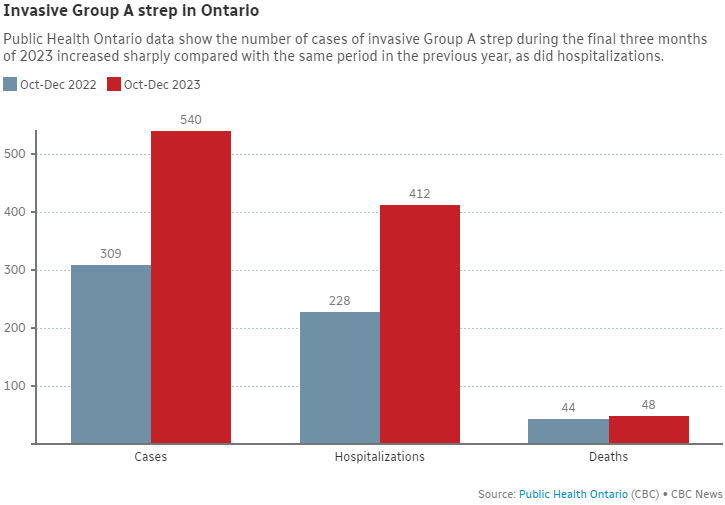Aggressive, often deadly form of strep hits record-high case numbers in Canada
Canada is seeing a record number of cases of invasive Group A strep, a bacterial infection that kills roughly one in 10 people who contract it, according to data obtained by CBC News.
More than 4,600 cases were confirmed in 2023 at the National Microbiology Lab in Winnipeg, an increase of more than 40 per cent over the previous yearly high, in 2019, says the Public Health Agency of Canada.
This trend emerges as a new report from Public Health Ontario shows six children have died of invasive Group A strep in the province since October.
Over the final three months of 2023, the number of cases in Ontario and hospitalizations from the disease were nearly double those during the same time period the previous year, says the report.
That’s prompting warnings from public health officials and medical experts about the potential severity of the disease.
“Whenever you see invasive group A strep, you have to be worried because usually the patient is quite sick,” said Dr. Donald Vinh, head of infectious diseases at McGill University Health Centre in Montreal.
“This is a serious infection and a potentially deadly one,” Vinh said in an interview.

Invasive Group A streptococcal disease happens when the common strep A bacteria spreads beyond the places it typically infects (such as the throat or skin) into sterile parts of the body, such as the bloodstream or the liquid around the brain, or into soft tissue, where it can cause necrotizing fasciitis, known as flesh-eating disease.
The latest report from Public Health Ontario on invasive Group A strep tallies 48 deaths from October to December, including six among children aged nine or younger.
Increases highest in older adults, younger children
“We’re monitoring this very closely,” said Dr. Liane Macdonald, a public health physician in the agency’s health protection section.
Dr. Brian Conway, medical director of the Vancouver Infectious Diseases Centre, describes the Ontario figures as very concerning.
“We need to understand why it happened, compare what’s going on in Ontario to what we’re seeing in the rest of the world and design a strategy to address it,” Conway said in an interview.
Ontario’s data show roughly three-quarters of people with a confirmed case of invasive Group A strep end up admitted to hospital. In the years leading up to the COVID-19 pandemic, around 10 per cent of cases resulted in death, although the rate differs among different age groups, tending to be higher in seniors.
There were 222 cases reported in December, more than in any month on record in Ontario.
Elsewhere in Canada:
B.C.’s Centre for Disease Control announced in December that the province is experiencing higher levels of infections compared to historical averages, particularly among children.
Quebec reported a 55 per cent increase in infections last year over its pre-pandemic average, and Montreal public health officials issued an alert after two children died in late 2022.
Manitoba reported 200 confirmed cases last year, 50 more than in 2022.
New Brunswick averaged six deaths per year before 2022, but saw 10 deaths in 2023 and has already reported two deaths this year.
About a year ago, the World Health Organization flagged a spike in cases and deaths across Europe, around the same time as a similar alert from the U.S. Centers for Disease Control.

‘I didn’t want to be a burden’
Quin Henderson, a five-year-old girl from Kitchener, Ont., died of infectious Group A strep in March, just 12 hours after her parents brought her to hospital.
Quin’s mother, Christina Hecktus, spoke to CBC News about her death “to tell other parents how fast it can be, and how invasive, and how devastating.”
Hecktus said she could not believe how quickly it happened.
“My daughter was sitting watching a movie, having a conversation with her nurses, and not six hours later she was gone,” Hecktus said.
Just three days earlier, Quin had a cough and seemed lethargic. She developed a fever the next day. Hecktus checked in by phone with her doctor and the province’s telehealth line, but says no one advised her to bring her daughter in for testing or treatment. On the third day of fever, when Quin’s breathing became shallow and her lethargy worsened, Hecktus took her to hospital.

“I didn’t want to be a burden on the system. I didn’t want to be that hypochondriac parent who takes them to the emergency room, thinking it’s just the sniffles,” said Hecktus.
“I regret that, every moment of the last nine months,” she said, her voice quivering with emotion.
Symptoms to watch for
Dr. Susy Hota, division head for infectious diseases at University Health Network in Toronto, says it can be a challenge for people to tell the difference between less serious infections and invasive Group A strep.
“If you have a severe sore throat without a cough or other cold or upper respiratory tract infection symptoms, if you have fever with it, if you’re feeling generally quite unwell with these symptoms, then seek medical attention,” said Hota in an interview.
Dr. Anna Banerji, a pediatrician and infectious disease specialist at University of Toronto, says parents can take their children to a family doctor or other primary care provider to be tested for strep infection so that it can be treated before becoming invasive.
Banerji says some of the signs that could indicate a strep infection include a very sore throat, a fine, sandpaper-like rash on the skin, extreme lethargy and fever. She says a runny nose and sneezing rarely indicate a case of strep.
“We don’t need to have parents panic more than they’re already panicking with COVID and other viruses and RSV,” Banerji said in an interview.
The B.C. Centre for Disease Control published a full list of symptoms to watch for last month.
While the Ontario data clearly shows notable increases in invasive Group A strep, what’s far from clear is why it’s happening.
COVID and other infections may play a role
Macdonald said there are “many possible factors,” adding that multiple strains of the bacteria have been identified among the cases in Ontario.
Vinh says the trajectory of the COVID-19 pandemic may be playing a role.
“With the return of normal social activities, you now have people who otherwise have lower collective protective immunity now being exposed to a strain or strains that may be easily transmissable,” he said.

Conway sees evidence of a link to recent increases in other infections such as COVID-19, RSV and influenza. He said three children who died recently in B.C. of invasive Group A strep all came down with it along with the flu.
“This is an example of what can happen if we don’t attend to things promptly,” Conway said, urging people to seek treatment if they have a severe throat infection, a skin infection that is getting worse or a high fever that isn’t going away.
“There are very effective antibiotics that can treat strep, and the sooner you get them, the better the outcome,” he said.
Ontario’s chief medical officer of health, Dr. Kieran Moore, told health care providers in a December memo that invasive Group A strep is commonly associated with co-infection with influenza, chickenpox or COVID-19, and emphasized the importance of being vaccinated against the viruses that cause those diseases.










Redes Sociais - Comentários